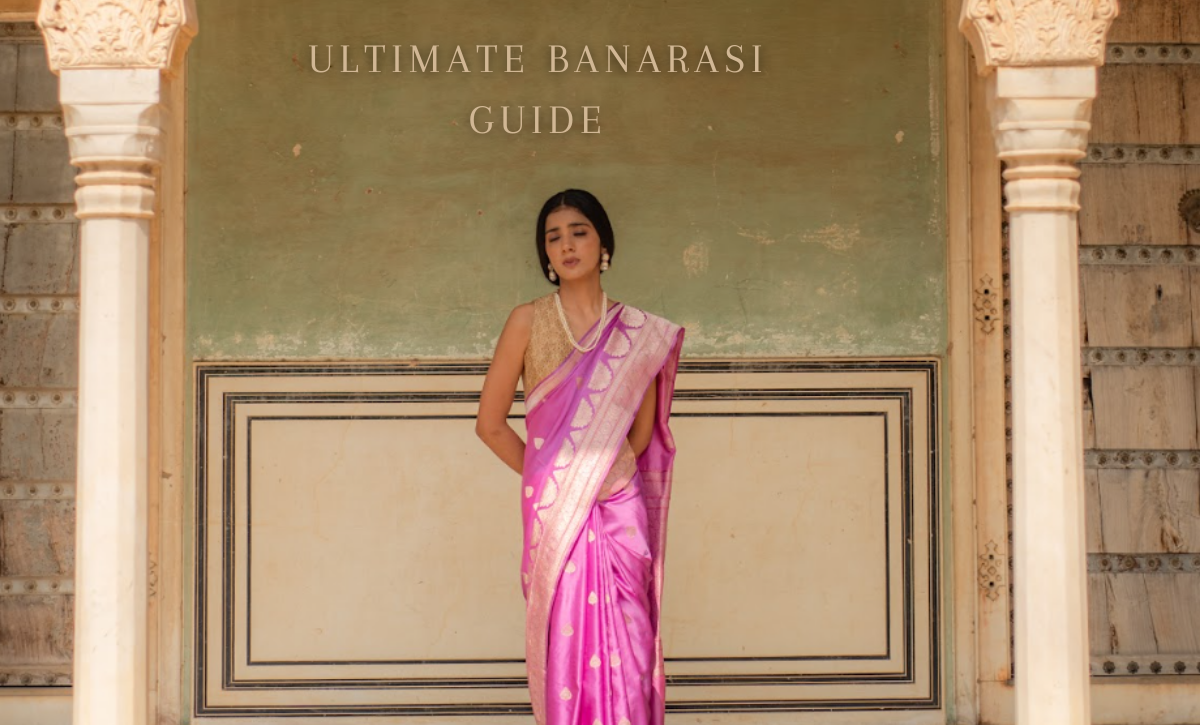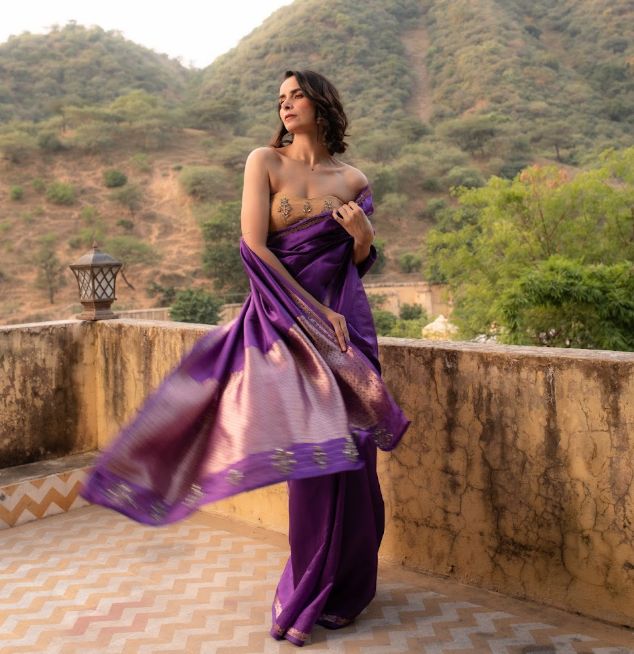Ultimate Guide: How to Choose a Pure Banarasi Silk Saree?

Ultimate Guide to Choosing the Perfect Banarasi Silk Saree
Think of an eye-catching, gorgeous saree from the town of Banares with highlights of gold and silver threads. Banarasi silk saree is what we all know.
Many of us have it in our closets. Renowned for its luxury, complex weaving techniques, and cultural significance.
The Banarasi silk saree is a precious treasure carried over generations. We'll explore the types, how to choose a pure Banarasi silk saree, and valuable tips on finding the perfect one for you.
History of making Banarasi Saree

It started in the 8th century and then evolved in the 14th century. It flourished well between the 16th and 18th centuries. The history of making each Banarasi saree is a masterpiece on its own.
“The Quintessential Banarasi silk saree is a timeless homage created by the selflessly
devoted artist from Banares - weaving art and culture together.”
Timeless Elegance: The picture was taken in the 1960s. During the wedding ceremony, the bride wore tissue silk woven with zari. This bridal saree was part of her granny’s collection.
Also Check: Collection of Chanderi Saree
Process of Making Banarasi Saree

The process of making an exquisite Banarasi saree starts with the preparation of silk yarns and silk twisting. Bleaching gets done. Sericin eliminated during the silk degumming procedure. It goes for yarn dyeing. Warp threads get starched, and they are spread horizontally on the loom.
Naqshaband, the Grapher creates traditional designs using cardboard stencils. This process is known as "Likhai.". Cardboard stencils are punched and fixed together to create a Naksha (pattern) which is suspended above the tana (warp threads) on the loom. Water is sprayed on the bana (weft threads) to maintain its softness and elasticity.
The shuttle contains weft threads. As per motif colours, the number of shuttles used. Now, the weaver throws the shuttle from one end to another in a weft-wise direction. Paddling is done at regular intervals to pick up the right colour yarn. Cutting, folding, and packaging are in the final stages.
The process of making Banarasi saree in a handloom takes time according to its intricacy. Handloom light-weight Banarasi silk saree would take a week, while a medium to intricate one would take a month. And for a heavy, detailed saree could take up to six months to complete. That's how the meticulous technique is!
Types of Banarasi Saree
There are two major types of Banarasi saree based on weaving techniques:
1. Kaduwa / kadhua

This technique can only done on handloom. In this technique, extra spools are utilized. Spools have a variety of colour yarns. To weave multiple motifs in a weftwise direction, the weaver has to focus on each motif rather than throwing a single shuttle from one end to another.
If five motifs are in the same row, each motif is viewed individually. Shuttle movement takes place to work on both sides of the zari borders.
The crucial work is to weave each motif separately along with the shuttle work.
A lot of work and attention increases when a single buti uses two or more colour yarns, which include gold and silver zari in many scenarios, or zari paired with a colour yarn.
The back of the Banarasi saree has no cutwork visible as there is no scope for loose threads.
2. Phekuwa

The back of the Banarasi saree has floats. Floats are identified as long loose threads intact between two adjacent motif weaves. This technique can be done on a machine loom.
Besides this, there are other types of Banarasi saree in the weaving technique variation:
Types of Banarasi Saree in The Weaving Technique
1. Kadiyal:

It is an ancient weaving technique that distinguishes between the patti(border) from the rest of the zamin (body) of the saree.
2. Meenakari:

This weaving technique aims for saree enhancement by using soft, glossy silk threads of preferred colors apart from the zari color.
3. Tanchoi:

It's a satin weave technique that deals with one or two color tana (warp threads ) with multiple color bana (weft threads). The pattern gets an embossed effect all over the saree.
4. Jangla Butidar:

This is one of the oldest techniques of kadua weaving in which the saree's zamin (body) is covered in a combination of floral and jali (net) patterns.
5. Jamdani-

The design in the saree is extremely visible because of its fine foundation in the weft and thicker base in the supplemental weft.
6. Cutwork

It is less costly since cotton threads are utilized and floats are cut and the threads usually come out.
Popular Types of Banarasi Saree Based on Different Fabrics:
- Katan Silk – It is a plain weave mulberry silk saree.
- Monga Silk – It has high tensile strength compared to other silk.
- Dupion Silk – It is a plain weave crisp silk with irregular weft & delicate warp.
- Linen – It is a strong, durable soft natural fabric.
- Cotton –It is also a natural fabric.
- Organza - It is a plain weave, lightweight & fine finish fabric.
- Khaddi Georgette – It is a "handwoven", lightweight wrinkled texture & easy to drape fabric.
- Shattir – It is a silk georgette fabric.
How to Identify Banarasi Silk Saree?
How to identify Banarasi saree will require background knowledge. The predominant fabric used in the weave is soft mulberry silk sourced from various regions of India – Kashmir, Bangalore & Tamil Nadu.
All kinds of pure silk are mainly used in the making of Banarasi saree like Tussar silk, Muga silk, Eri silk, katan silk, and kora silk, etc. Look for the intricate zari work, fine texture, and distinctive patterns.
No animal or human motifs can be seen in the pattern. You can identify by rubbing the saree’s one portion to the other, silk yarns do not produce noise while rubbing.
Tips to Find a Pure / Authentic Banarasi Saree:
Tips for finding a pure handcrafted Banarasi saree revolve around its quality material, textures, cost, weight, and weaving process. Distinguishing a genuine Banarasi silk saree requires an understanding of its hallmark features.
Consider This Things Before Buying a Banarasi Saree
1. Silk Mark
The Silk Mark tag will ensure the purity of the silk. It is the assurance for the Silk Mark recognized by the Government of India. SMOI mentioned in the Silk Mark tag stands for Silk Mark Organisation Of India.
2. Cost range
It is usually expensive and well-known for slow luxury fashion. The cost range generally falls between 36K - 1L.
3. Quality
You can check the finesse of the pure Banarasi silk saree by touch and feel.
Look at Zari’s shine – Gold/ Silver threads in the saree.
4. Texture
You can check the lustrous by sight & touch - shine and soft feel.
5. Weaving process
You can check for the presence of the kaduwa technique which is proven to be handcrafted by the artist. Notice the reverse side of the saree.
6. Weight
The heaviness of the fabric is there as the tana (warp) is made of two-ply yarns and the bana (weft) is made of double the tana yarns.
7. Pin marking
Pinhole marks can be present at equal distances at the top/bottom of the saree. This feature signifies that it is a handloom product.
Label Priyankaraajiv presents you with pure Banarasi sarees at affordable prices. The ultimate experience of witnessing the elegance, exclusivity, and diversity of authentic handcrafted Banarasi silk sarees that we offer at the Priyankaraajiv store.
How to Select The Perfect Banarasi Saree?
Selecting the perfect Banarasi saree depends on a person's preferences for color scheme, pattern, design & variety of fabric.
You may choose between the traditional style, the indo-western look, and customary ceremonies like bridal attire. Depending on the occasion and style of the saree, you can choose a light to heavy one.
Where to Find Pure Banarasi Saree?
Pure Banarasi Saree is available only in handloom emporiums, renowned shops, luxurious brands, renowned saree boutiques, and trusted online sites.
Tips - Try to see the transparency in the detailed information about the saree available from the seller. You can look out for the weaving technique and its origin.
Label Priyankaraajiv presents you with a wide range to opt for according to your choice of fabric in Banarasi Sarees. By the way, every woman likes to have a lot of options to choose from. Don't miss out on the fun of exploring the variety of Pure Banarasi saree at the Priyankaraajiv store.
Conclusion
After globalization, imitations have started to cater major audience of the population to increase their business scale. In the past, it was exclusively for royals and elites.
After the 1980s, cheap and fake sarees had more appearance in the market. In the name of the Banarasi silk saree, businesses started to replace it with synthetic fabric and nylon threads to create the zari resemblance. A lot of variations and names were introduced with different techniques with the saree.
To tackle this situation in the handloom industry, initiatives were taken.
Banarasi silk receives GI rights (India) – Geographical Indication registered with the name - ‘Banaras Brocades & Sarees’.
GI status is the measure to restrict the misuse of the Banaras saree brand. It would benefit about 1.2 million individuals who are linked with the handloom silk industry.
Ultimate Guide: Frequently Asked Questions
Q1. Which blouse suits Banarasi's saree?
Ans. Plain blouses of the same color will give you the traditional outlook whereas contrast blouses or golden zari blouses will give you the contemporary outlook.
Q2. Why is Banarasi silk so expensive?
Ans. Banarasi silk is expensive due to the pure silk and the materials used - Gold/ Silver threads and craftsmanship. Skilled artists, time, and patience are required to achieve intricacy.
Banarasi weavers possess the ability to work on complex design patterns with more than a decade of practice. The craftsmanship that gives Banarasi silk sarees their authenticity and traditional touch is the reason for its timeless beauty.
Q3. Are Banarasi sarees heavy?
Ans. Yes, pure Banarasi sarees are heavy and intricate from medium to heavy depending on the fabric.
Q4. What is the difference between pure silk and Banarasi silk?
Ans. Pure Silk may not necessarily have the specific type of complex weaving techniques and high cultural significance as Banarasi silk does.

